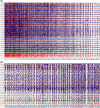Progressive slowing of clonic phase predicts postictal generalized EEG suppression
- PMID: 36208032
- PMCID: PMC10092045
- DOI: 10.1111/epi.17434
Progressive slowing of clonic phase predicts postictal generalized EEG suppression
Abstract
Objective: Postictal generalized electroencephalography (EEG) suppression (PGES) is a surrogate marker of sudden unexpected death in epilepsy (SUDEP). It is still unclear which ictal phenomena lead to prolonged PGES and increased risk of SUDEP. Semiology features of generalized convulsive seizure (GCS type 1) have been reported as a predictor of prolonged PGES. Progressive slowing of clonic phase (PSCP) has been observed in GCSs, with gradually increasing inhibitory periods interrupting the tonic contractions. We hypothesized that PSCP is associated with prolonged PGES.
Methods: We analyzed 90 bilateral convulsive seizures in 50 consecutive patients (21 female; age: 11-62 years, median: 31 years) recruited to video-EEG monitoring. Five raters, blinded to all other data, independently assessed the presence of PSCP. PGES and seizure semiology were evaluated independently. We determined inter-rater agreement (IRA) for the presence of PSCP, and we evaluated its association, as well as that of other ictal features, with the occurrence of PGES, prolonged PGES (≥20 s) and very prolonged PGES (≥50 s) using multivariate logistic regression analysis.
Results: We found substantial IRA for the presence of PSCP (percent agreement: 80%; beyond-chance agreement coefficient: .655). PSCP was an independent predictor of the occurrence of PGES and prolonged PGES (p < .001). All seizures with very prolonged PGES had PSCP. GCS type 1 was an independent predictor of occurrence of PGES (p = .02) and prolonged PGES (p = .03) but not of very prolonged PGES. Only half of the seizures with very prolonged PGES were GCS type 1.
Significance: PSCP predicts prolonged PGES, emphasizing the importance of gradually increasing inhibitory phenomena at the end of the seizures. Our findings shed more light on the ictal phenomena leading to increased risk of SUDEP. These phenomena may provide basis for algorithms implemented into wearable devices for identifying GCS with increased risk of SUDEP.
© 2022 The Authors. Epilepsia published by Wiley Periodicals LLC on behalf of International League Against Epilepsy.
Figures

Similar articles
-
Tonic electromyographic activity following bilateral tonic-clonic seizures is associated with periictal respiratory dysfunction and postictal generalized EEG suppression.Epilepsia. 2019 Feb;60(2):268-274. doi: 10.1111/epi.14632. Epub 2019 Jan 10. Epilepsia. 2019. PMID: 30630218
-
Age-specific periictal electroclinical features of generalized tonic-clonic seizures and potential risk of sudden unexpected death in epilepsy (SUDEP).Epilepsy Behav. 2013 Nov;29(2):289-94. doi: 10.1016/j.yebeh.2013.08.010. Epub 2013 Sep 5. Epilepsy Behav. 2013. PMID: 24011708 Free PMC article.
-
Periictal electroclinical characteristics of postictal generalized electroencephalographic suppression after generalized convulsive seizures.Medicine (Baltimore). 2020 May;99(20):e19940. doi: 10.1097/MD.0000000000019940. Medicine (Baltimore). 2020. PMID: 32443294 Free PMC article.
-
Strategies for non-EEG seizure detection and timing for alerting and interventions with tonic-clonic seizures.Epilepsia. 2018 Jun;59 Suppl 1:36-41. doi: 10.1111/epi.14046. Epilepsia. 2018. PMID: 29873833 Review.
-
Genetic and Cellular Mechanisms Underlying SUDEP Risk.In: Noebels JL, Avoli M, Rogawski MA, Vezzani A, Delgado-Escueta AV, editors. Jasper's Basic Mechanisms of the Epilepsies. 5th edition. New York: Oxford University Press; 2024. Chapter 63. In: Noebels JL, Avoli M, Rogawski MA, Vezzani A, Delgado-Escueta AV, editors. Jasper's Basic Mechanisms of the Epilepsies. 5th edition. New York: Oxford University Press; 2024. Chapter 63. PMID: 39637214 Free Books & Documents. Review.
References
-
- Devinsky O. Sudden, unexpected death in epilepsy. N Engl J Med. 2011;365(19):1801–11. - PubMed
-
- Shorvon S, Tomson T. Sudden unexpected death in epilepsy. Lancet. 2011;378(9808):2028–38. - PubMed
-
- Thurman DJ, Hesdorffer DC, French JA. Sudden unexpected death in epilepsy: assessing the public health burden. Epilepsia. 2014;55(10):1479–85. - PubMed
-
- Bird J, Dembny K, Sandeman D, Butler S. Sudden unexplained death in epilepsy: an intracranially monitored case. Epilepsia. 1997;38:S52–S6. - PubMed
-
- Lhatoo SD, Faulkner HJ, Dembny K, Trippick K, Johnson C, Bird JM. An electroclinical case‐control study of sudden unexpected death in epilepsy. Ann Neurol. 2010;68(6):787–96. - PubMed
Publication types
MeSH terms
LinkOut - more resources
Full Text Sources
Medical

